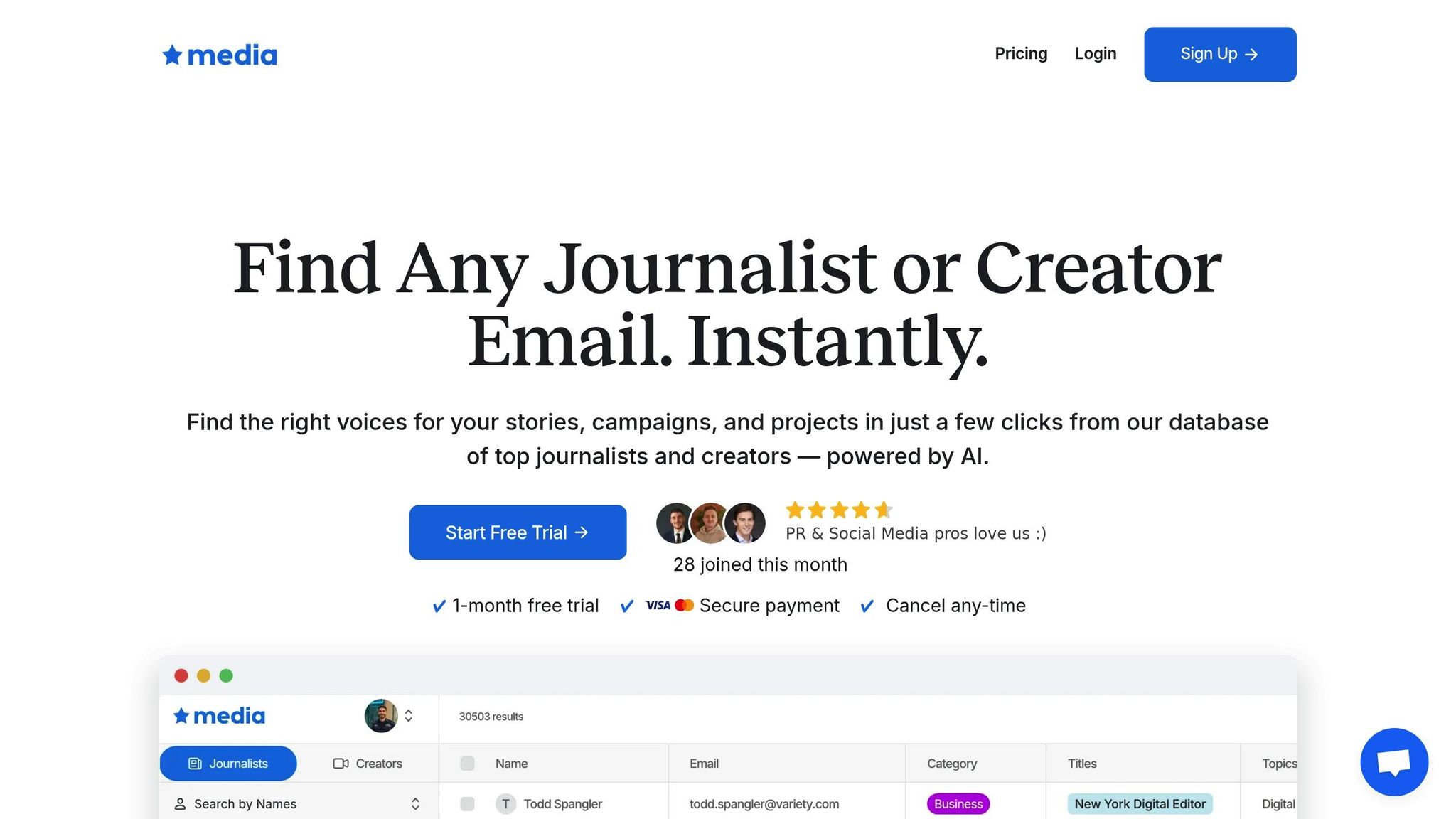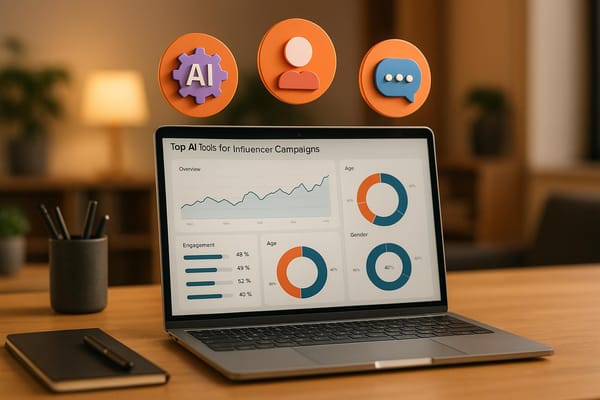How AI Helps Personalize PR for Regional Audiences
Explore how AI transforms regional PR by delivering customized messaging that resonates with diverse audiences across the U.S.

AI is transforming regional PR by enabling tailored messaging that connects with different audiences across the U.S. Here's how it works:
- AI analyzes vast amounts of data - like local trends, media habits, and journalist preferences - to fine-tune PR campaigns for specific regions.
- It helps PR teams create pitches that align with regional interests, such as highlighting job creation in the Midwest or sustainability on the West Coast.
- Tools like Media AI streamline tasks like audience segmentation, journalist targeting, and crafting region-specific press releases, saving time and resources.
- AI also adjusts for local language, timing, and media formats, ensuring messages resonate with diverse audiences.
Key Takeaways:
- Efficiency: AI reduces the time needed to research and execute regional campaigns.
- Precision: It identifies the right journalists and media outlets for targeted outreach.
- Customization: Messages are tailored to regional values and preferences.
While AI simplifies the process, human oversight remains crucial to ensure messaging is accurate, culturally aware, and engaging.
AI Powered PR | How to get more media exposure in less than 5 minutes
Core AI Capabilities for Regional PR Customization
AI-driven PR tools bring a host of features to the table, making it easier to adapt broad PR campaigns for specific regional markets. These capabilities work together to fine-tune every step of personalizing PR efforts for local audiences.
Adapting to Local Language and Context
Advanced AI systems can pick up on regional dialects, local expressions, and cultural subtleties, helping tailor messaging to resonate more effectively with specific audiences. By analyzing local publications, social media discussions, and news trends, these tools identify the language patterns that matter most in a given region. For example, they can emphasize themes like economic recovery or environmental awareness when those topics are especially relevant locally. Additionally, built-in features for cultural awareness ensure that messaging avoids references or phrasing that might not connect universally. This means technical jargon is simplified for broader audiences while still highlighting detailed insights for more niche platforms. From there, AI takes audience targeting to the next level.
Audience Segmentation for Regional Targeting
AI-powered segmentation dives deep into audience behavior, creating detailed profiles based on factors like location, demographics, and media habits. This goes well beyond basic zip code targeting, uncovering regional preferences that can shape a campaign’s messaging. For instance, AI can identify whether a region’s audience prefers digital platforms, print media, or hyper-local community content, allowing PR professionals to adjust their approach accordingly. Timing is another area where AI shines, helping teams align outreach with regional news cycles or local events. Plus, these tools integrate seamlessly with existing PR workflows and CRM systems, making it easy to export targeted contact lists, track outreach, and evaluate the success of regional campaigns.
Using Local Media Databases
Once language and audience insights are in place, AI leverages comprehensive media databases to sharpen targeting even further. Tools like Media AI offer access to over 30,000 journalists and creators, with advanced filtering options for precise regional targeting. Geographic filters enable PR teams to find media contacts at the state, city, or even neighborhood level. Additionally, beat and specialty tracking helps match stories to the right reporters by analyzing their recent articles, social media posts, and coverage patterns. Automated updates and contact verification ensure that outreach efforts stay focused on active and relevant media professionals, boosting the chances of campaign success.
Step-by-Step Guide: Using AI to Personalize PR for Regional Audiences
Follow these steps to leverage AI for creating PR campaigns tailored to specific US regional markets, from the tech-driven crowd in Silicon Valley to the farming communities of the Midwest.
Step 1: Collect and Analyze Regional Media Data
Every successful regional PR campaign begins with a solid foundation of data. The first step is to identify your target regions and gather insights on local media outlets, audience preferences, and regional characteristics.
Start by using tools like Media AI's advanced filtering system to create localized contact lists. These geographic filters allow you to pinpoint journalists and creators by state, city, or even specific metro areas. For instance, if you're launching a fintech product in Texas, you can filter for financial reporters who cover the Dallas-Fort Worth and Houston areas.
It’s important to consider the specialization of each journalist's beat. For example, a healthcare story will resonate differently in cities like Boston or Rochester, Minnesota - both known for their medical hubs - compared to regions where agriculture or manufacturing plays a bigger role. Media AI’s filters can help you zero in on reporters who frequently cover your industry in your target areas.
Additionally, analyze local media consumption patterns to determine the best content formats and optimal engagement times. For example, audiences in the Pacific Northwest might respond more to stories with environmental themes, while those in the Southeast may gravitate toward narratives about economic growth and job creation.
Once you’ve gathered accurate regional data, you can use it to tailor your messaging. Media AI simplifies this process by helping you build and refine your regional contact lists.
Step 2: Generate Tailored PR Pitches
Use AI tools to craft PR pitches that reflect the unique priorities, events, and cultural context of each region. These tools can adapt your overarching message to align with local nuances effectively.
Start by providing your AI tool with relevant regional information, such as current news trends, upcoming events, seasonal factors, and economic conditions in your target area. For example, pitches targeting Florida could emphasize disaster preparedness, while those for California might focus on wildfire resilience.
Timing is another critical factor. AI can help identify the best times for outreach by analyzing regional news cycles, events, and seasonal patterns. For instance, a back-to-school campaign in Arizona would need to launch earlier, as schools there often start in early August, compared to Massachusetts, where the school year traditionally begins after Labor Day.
Tailor the tone and style of your messaging to suit the region. A pitch for New York media might be more direct and fast-paced, while a Southern audience might prefer a warm, conversational approach that emphasizes relationships.
AI can also identify opportunities for local partnerships or tie-ins. For example, connecting your story to regional businesses, universities, or community organizations can make your announcement more relevant and impactful by highlighting benefits like job creation or community support.
Before finalizing, ensure your pitch captures all regional nuances and aligns with the preferences of your target audience.
Step 3: Review and Refine for Accuracy
The final step is to carefully review all AI-generated content to ensure accuracy, cultural appropriateness, and strategic alignment. This step helps avoid potential missteps and ensures your message resonates with local audiences.
Double-check content for cultural relevance and accuracy. Even within the US, regional differences in values and communication styles can significantly impact how your message is received. What works in urban hubs like Seattle or Portland may not resonate with rural communities in the same region.
Verify all local references by cross-checking with reliable sources to ensure that mentions of events, businesses, or geographic details are accurate and up-to-date.
Make sure your content adheres to US conventions, such as using the $ symbol for currency, MM/DD/YYYY for dates, and imperial units for measurements.
Lastly, confirm the accuracy of your regional media contact lists. While tools like Media AI provide regularly updated databases, it’s always a good idea to double-check key contacts, especially at smaller outlets where staff turnover may be more frequent. This ensures your tailored pitches reach the right people at the right time.
Benefits and Challenges of AI-Driven Regional PR
AI-driven tools offer exciting opportunities for regional PR personalization, but they also come with hurdles that PR teams need to address. Understanding both the potential and the pitfalls is essential for effectively incorporating AI into regional campaigns.
Advantages of AI in Regional PR
One of the biggest advantages of using AI in regional PR is scalability and efficiency. Traditionally, creating personalized campaigns for different regions required hours of manual work, making it hard to cover multiple areas at once. Now, tools like Media AI can handle this workload by automating tasks like adapting messages for local audiences, identifying relevant journalists, and customizing pitches based on regional context.
Another key benefit is that AI speeds up outreach during regional news cycles. When a major story breaks in a particular area, AI can quickly analyze the local angle, craft relevant pitches, and send them to the most suitable journalists in a matter of hours. This kind of rapid response is especially crucial for crisis communications or leveraging trending topics.
Precision targeting is another strength. AI can analyze data points such as geographic location, journalist beat, publication reach, and past engagement patterns to identify the most relevant reporters for a story. This targeted approach reduces wasted effort and improves response rates.
Cost-effectiveness is also a major draw. While there may be an upfront investment in AI tools, they allow one person to manage tasks that used to require an entire team. Over time, this significantly reduces the cost of running campaigns.
Lastly, data-driven insights help PR teams refine their strategies. By tracking what works - whether it's the timing of outreach, specific messaging, or regional variations - AI provides actionable feedback that can improve future campaigns.
But while these advantages are compelling, they come with challenges that require careful attention.
Challenges and Potential Problems
Despite its strengths, AI in regional PR is not without its challenges. One major concern is the risk of losing authenticity. Over-relying on AI-generated content without human review can result in campaigns that feel impersonal or culturally off-key. Regional audiences are quick to pick up on messaging that feels generic or tone-deaf, which can damage a brand’s reputation.
Another issue is cultural nuance. While AI is excellent at processing data, it often struggles with subtleties like regional humor, historical sensitivities, or local traditions. Without human oversight, even the most data-driven campaign can miss the mark or inadvertently offend.
Generic content is another pitfall. AI tools can produce technically correct messaging, but if not customized, the lack of a personal touch can make brands seem out of sync with local communities.
As campaigns grow, quality control becomes increasingly complex. Reviewing AI-generated content across multiple regions requires time and expertise. Without a solid quality check process, mistakes or inappropriate messages could slip through.
There’s also the issue of technology dependence. If AI tools experience glitches, downtime, or inaccuracies, PR teams without a backup plan may find themselves unable to execute time-sensitive campaigns.
Finally, there’s a learning curve. Teams need to develop new skills, refine how they interact with AI tools, and establish workflows for reviewing content. This adjustment period can temporarily slow down campaign execution.
Comparison Table: Pros and Cons of AI in Regional PR
Here’s a quick summary of the advantages and challenges:
| Advantages | Challenges |
|---|---|
| Scale campaigns across multiple regions simultaneously | Risk of over-automation leading to generic messaging |
| Generate personalized content in hours instead of days | Potential to miss cultural nuances without human oversight |
| Pinpoints regional journalists effectively | Quality control becomes more complex at scale |
| Reduce cost per campaign significantly | Increased vulnerability due to technology dependence |
| Provide data-driven insights for continuous improvement | Requires a steep learning curve for effective use |
| Respond quickly to regional news and trends | Risk of generating generic content without customization |
| Track performance metrics across all regional markets | May lack an authentic local voice and cultural sensitivity |
The key to success lies in blending automation with human expertise. AI can handle the heavy lifting - like data analysis, content creation, and journalist targeting - while PR professionals focus on ensuring the messaging is culturally relevant, authentic, and high-quality. By striking this balance, regional PR campaigns can be both efficient and meaningful.
Best Practices for Personalizing PR for the US Market Using AI
The US market is incredibly diverse, and personalizing AI-driven PR efforts requires a thoughtful and strategic approach. By following these best practices, you can fine-tune your campaigns to resonate with different regions and audiences, ensuring they align with local preferences and values.
Ensure Sensitivity and Relevance
The US is a patchwork of distinct regions, each with its own language nuances, cultural values, and media consumption habits. To make your PR efforts effective, AI-driven messaging must account for these differences. For instance, a pitch for the Northeast might benefit from a straightforward tone, while a message tailored for the South could adopt a more conversational approach.
Language and themes also vary widely. A campaign aimed at Texas audiences might highlight themes like independence and state pride, while messaging for the Pacific Northwest could focus on sustainability and forward-thinking initiatives. While AI tools can analyze past campaigns and local media trends to identify these nuances, human oversight remains essential for capturing the finer details that machines might miss.
Cultural sensitivity is especially important when addressing topics that resonate differently across regions. Take healthcare, for example: in Boston, the focus might be on innovation in the medical field, while in rural areas, affordability could take center stage, and in urban settings, accessibility might be the key concern. AI can help identify trending topics regionally, but the final messaging needs a human touch to ensure it aligns with local values while staying true to your brand's identity.
Use AI Tools Like Media AI

Once you've built a solid understanding of regional differences, AI tools like Media AI can help you target your messaging with precision. In the past, finding the right journalists for regional campaigns was a time-consuming task, but Media AI simplifies this process with its extensive database of over 30,000 journalists and creators. Advanced filters allow you to narrow your search by location, beat, and publication reach.
For example, if you're working on a campaign promoting renewable energy adoption in California, Media AI can quickly identify environmental journalists at key local outlets and sustainability-focused creators in West Coast markets. This kind of targeted outreach, which would have been nearly impossible to execute manually at scale, becomes manageable and efficient.
Media AI also offers a cost-effective pricing model at $99/month for access to its Journalist Database, which is significantly lower than many competitors. For agencies juggling multiple regional campaigns, this can result in considerable savings without sacrificing access to up-to-date contact information.
The platform’s features don’t stop there. You can create and export tailored press lists - say, one for Midwest manufacturing reporters, another for Southwest tech journalists, and yet another for Southeast lifestyle creators - directly into your outreach tools. With real-time updates to the database, you’ll also reduce bounce rates and improve the overall effectiveness of your campaigns.
Perform Regular Content Reviews
Even with the help of AI, regular content reviews are essential to ensure quality and appropriateness across regional campaigns. Establishing review checkpoints can help you avoid missteps, like tone-deaf messaging, and ensure consistency with US standards for formatting dates (MM/DD/YYYY), currency (e.g., $1,234.56), and measurement units (Fahrenheit, miles).
Start with a cultural context check. For instance, AI might suggest that a story about urban growth would resonate in cities like Austin or Nashville, but human reviewers need to confirm that the message addresses local concerns, such as gentrification or infrastructure challenges, in a respectful and informed way.
Fact-checking is another crucial step. Any references to local landmarks, recent events, or regional developments should be verified for accuracy. This not only protects your brand’s reputation but also strengthens the credibility of your campaign. By incorporating these regular checks, you’ll set a strong foundation for consistent success across regional markets.
Conclusion: Regional PR Success with AI
AI is reshaping regional PR by making it possible to deliver scalable, culturally nuanced messaging tailored to diverse audiences across the U.S. It simplifies the once time-intensive tasks of analyzing regional trends and segmenting audiences - work that used to take weeks of manual effort.
A structured strategy that includes gathering data, crafting targeted pitches, and fine-tuning content has proven to be a winning formula. Tools like Media AI, which connects PR teams to over 30,000 journalists and creators, further enhance this process. These platforms allow professionals to target specific regional markets with precision, cutting down on both time and costs traditionally associated with such efforts.
That said, technology alone isn’t enough. The human touch remains indispensable. For AI-driven regional PR to succeed, campaigns must combine the analytical strengths of AI with human cultural understanding and regular content evaluation. This partnership ensures messages feel genuine to local audiences while staying true to the brand’s overall identity. It’s this balance that defines the modern PR approach.
For PR professionals working in regional markets, integrating AI is no longer optional - it’s necessary. The ability to tailor messages to different cultural contexts, connect with the right local media, and scale personalized outreach gives teams a clear edge in forming meaningful relationships with local communities.
The future of regional PR lies in this partnership between AI and human creativity. AI takes care of the heavy lifting - data analysis, trend identification, and contact discovery - while professionals focus on crafting messages that resonate deeply with local audiences. Together, they create campaigns that are both efficient and impactful.
FAQs
How does AI help create culturally relevant and regionally tailored PR messages?
AI plays a key role in shaping PR messages that resonate with regional audiences. By analyzing language nuances, tone, and context, it helps tailor content to fit the unique characteristics of specific markets. It also flags potential cultural sensitivities, ensuring messaging avoids missteps and remains respectful, which ultimately makes campaigns more relatable and engaging.
On top of that, AI tools leverage social listening to uncover insights about regional preferences and trends. This allows PR professionals to create messages that align closely with local interests and values. The result? Communication that feels more personal and builds stronger connections across diverse markets.
What challenges do PR teams face when using AI for regional campaigns, and how can they address them?
PR teams often grapple with maintaining a personal touch and fostering emotional connections when incorporating AI into their strategies. These tools, while efficient, can sometimes fall short in areas like empathy and originality. On top of that, ethical concerns - such as the risk of spreading misinformation, ensuring transparency, and safeguarding data privacy - can make using AI in regional campaigns more complex.
To navigate these challenges, blending AI capabilities with human oversight is key. This approach helps ensure that messages remain genuine and culturally relevant. At the same time, prioritizing ethical practices, like clear and responsible data use, can strengthen trust with regional audiences and align with privacy regulations. Striking the right balance between AI's speed and human insight allows PR teams to craft campaigns that connect meaningfully with local audiences while adhering to ethical standards.
How does AI, like Media AI, make regional PR campaigns more effective and efficient compared to traditional methods?
AI-powered tools like Media AI are reshaping the way regional PR campaigns are managed. They take over labor-intensive tasks like audience segmentation, media monitoring, and identifying influencers. This not only speeds up campaign execution but also ensures campaigns are fine-tuned to reach specific audiences with precision, aligning with regional and cultural nuances.
With a database of over 30,000 journalists and creators, Media AI streamlines the process of finding the right partners for collaboration. By prioritizing cultural relevance and regional preferences, these tools help boost engagement and secure broader media coverage. Unlike traditional, manual research methods, AI-driven platforms offer faster, scalable, and data-driven PR strategies. The result? More impactful campaigns and smarter allocation of resources.





